Why Companies Choose to Work with Hicron Software
- November 28
- 10 min

Choosing the right software team setup can make or break a tech partnership. Whether you rely on remote software teams working from around the globe or onsite software teams collaborating under one roof, both approaches come with unique benefits and challenges. But what if the real secret to success isn’t about choosing one over the other? Onsite or Remote Software Teams? How to Pick and Combine for Maximum Impact? It lies in finding the perfect balance and knowing when to leverage each model for maximum impact.
Remote software development teams bring unparalleled flexibility and access to top talent worldwide, while onsite teams foster deeper trust and swift collaboration. Blending these two approaches, however, requires more than just strategy; it demands clear communication, mutual trust, and the ability to adapt to changing priorities.
Drawing from real-world experiences and hard-earned lessons, this post will explore:
Whether you’re navigating time zone hurdles, aligning cultural dynamics, or simply seeking ways to boost your team’s efficiency, this guide will help you make informed decisions that lead to stronger, more successful partnerships.
Remote and onsite software development teams represent two distinct approaches to collaboration in tech partnerships, each offering unique advantages. Remote teams consist of professionals working from various locations, often across multiple time zones, leveraging digital tools to stay connected. Onsite teams, on the other hand, are based in a shared physical space, enabling immediate, face-to-face interactions.
Remote software development teams consist of individuals who work from different cities, countries, or even continents. These teams leverage technology to collaborate, often excelling in situations that demand flexibility and access to a diverse talent pool. By operating in varied time zones, remote teams can facilitate round-the-clock productivity, which is especially beneficial for global tech collaborations.
On-site software development teams operate together in a single physical location, fostering real-time, in-person collaboration. This setup is particularly effective for tackling complex challenges, driving creativity in brainstorming sessions, and accelerating decision-making during critical deployment phases. On-site teams thrive in scenarios where immediate interaction and cohesion are essential.
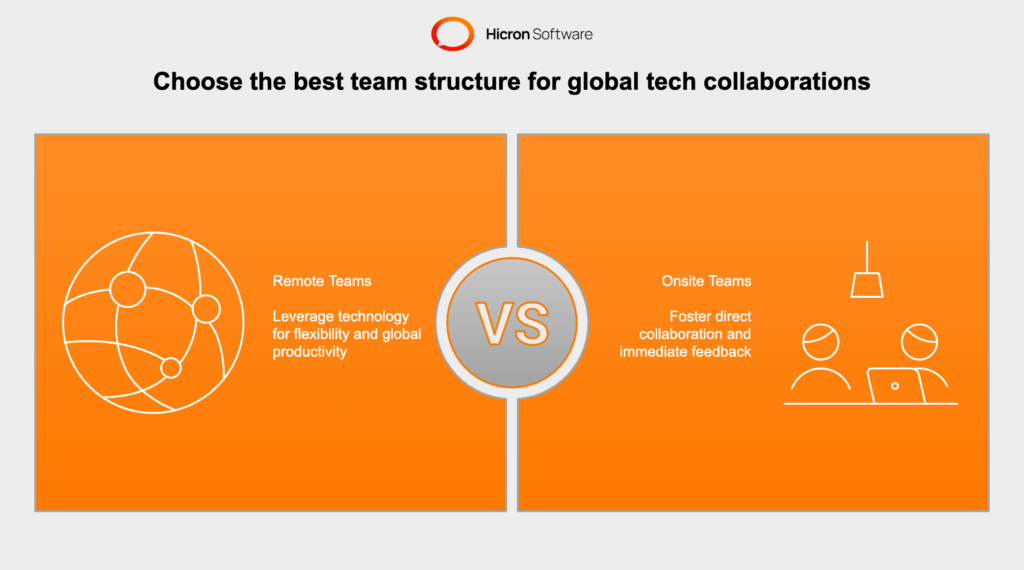
Remote software development teams are ideal for projects that require talent diversity and cost-efficiency. For example, a tech company needing continuous development work might rely on remote teams spread across regions to maintain around-the-clock progress.
Onsite software development teams are better suited when instant communication and face-to-face problem-solving are needed. Projects involving platform launches or urgent troubleshooting can benefit greatly from having a co-located team to address challenges in real time.
The complementary strengths of remote and onsite teams offer a unique edge when combined effectively in tech partnerships. Remote software development teams bring flexibility, specialized expertise, and scalability, while onsite teams enhance trust-building and collaboration speed at pivotal moments. A well-designed hybrid approach can harness the best of both worlds.
Imagine a scenario where a tech company is launching a software product. The design and coding phases are handled by a remote team of developers and UX designers across Europe, ensuring around-the-clock workflow. When the project moves into the final testing and rollout phases, an onsite team of engineers and project managers work closely together to address last-minute challenges. This hybrid model ensures both efficiency and precision, driving the success of the partnership.
By understanding how remote teams and onsite teams function within tech partnerships, and learning when and how to leverage each, organizations can craft more efficient, adaptable strategies built for success.
Navigating the challenges of remote and onsite teams is essential for success in tech partnerships. While each model offers unique advantages, they also come with obstacles that can impact project alignment, productivity, and costs. Here’s a closer look at the specific challenges faced by remote teams and onsite teams, along with real-world examples to provide actionable insights.
Remote software development teams often work across multiple time zones, making it a challenge to coordinate shared work hours. Overlapping schedules may be limited, leading to delays in communication and project updates. For instance, a developer in one region may need to wait hours for feedback from a project manager in another time zone, slowing down delivery timelines.
Another hurdle remote teams frequently encounter is the communication gap. Without in-person interactions, there’s a higher risk of misinterpreting instructions or missing important context during virtual meetings. This can create alignment issues, especially in fast-paced projects where clarity is key.
Building relationships within remote software teams can also be difficult. The lack of casual, face-to-face moments means fewer opportunities to establish trust and camaraderie among team members. This can impact collaboration and morale over time.
Real-World Insight:
Consider a software development project where a company used a remote team spread across Europe and North America. During a phase where priorities shifted unexpectedly, the team implemented daily stand-ups at overlapping times and clear documentation of decisions. These measures ensured all members stayed informed and minimized disruptions caused by the time zone gap.
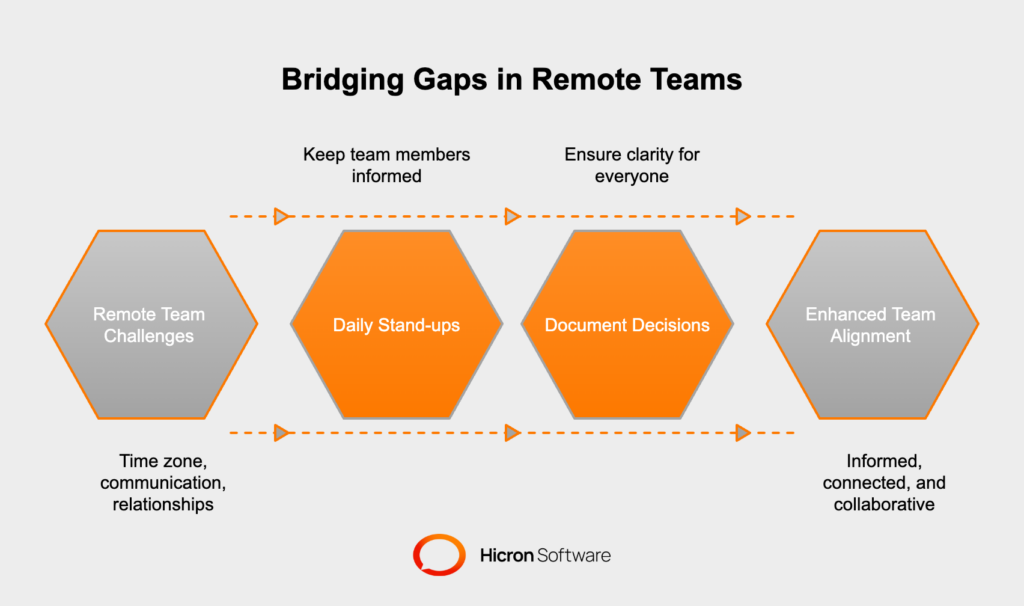
Onsite software teams operate in close physical proximity, which often reduces communication delays. However, maintaining onsite teams involves higher costs, such as office space, equipment, and travel. These expenses can strain budgets, especially for startups or smaller tech partnerships.
For larger groups, logistical coordination can become an issue. Scheduling meetings, allocating workspaces, and managing onsite resources can create inefficiencies, particularly when there are last-minute changes in project priorities.
Onsite teams may also face resistance to flexibility. Some team members might lean too heavily on face-to-face problem-solving, which could limit the integration of remote collaboration tools or hybrid strategies.
Real-World Scenario:
Imagine an onsite team tasked with troubleshooting a critical deployment. While fast, in-person collaboration helped resolve technical issues, shifting client expectations created tension that required adaptive communication strategies. By introducing structured feedback sessions and team workshops, the organization improved its ability to manage evolving requirements without sacrificing efficiency.
Both remote and onsite software development teams play critical roles in tech partnerships, but each comes with its own complexities. From time zone management and communication gaps in remote teams to higher costs and logistical challenges with onsite teams, understanding these obstacles is the first step toward creating a strategy that mitigates them effectively.
Combining thoughtful coordination and adaptive strategies helps work through these challenges and ensures smoother collaboration.
Understanding the value that both remote and onsite teams bring to tech partnerships is crucial for optimizing your collaboration strategy. Each model offers unique advantages that can significantly impact project success when used effectively. Let’s explore the benefits in detail.
Remote teams excel in providing flexibility and access to a diverse talent pool. By working with professionals from around the globe, companies can bring together highly specialized skills that may not be available locally. This advantage is particularly critical in fields like software development and data analysis, where niche expertise can be a game-changer.
Another key benefit of remote software teams is the cost savings they offer. Businesses can reduce expenses related to physical office space, commuting, and travel. For startups or organizations operating with limited resources, these savings can be reinvested in innovation or scaling efforts.
Additionally, remote software team setups encourage a focus on results rather than processes. With clear goals and deliverables, team members often work with heightened accountability and productivity, driving faster outcomes while maintaining quality.
Real-World Insight:
A tech company seeking to build a scalable mobile app employed a remote team comprising developers from Europe. This setup reduced overhead costs and provided round-the-clock development, allowing the company to complete the project ahead of schedule and under budget.
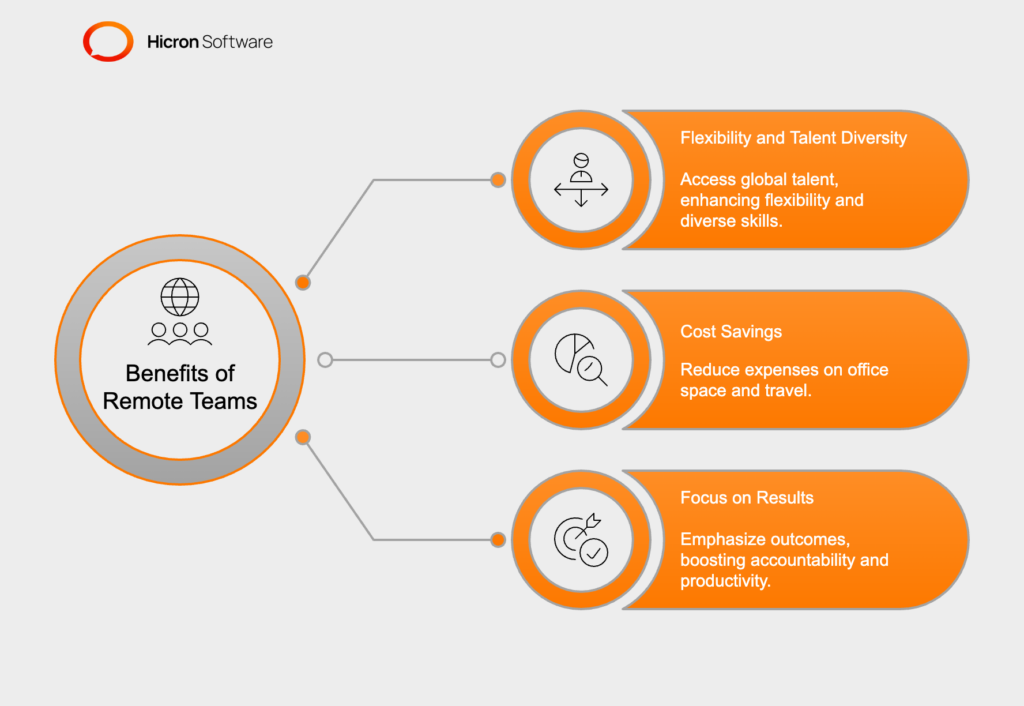
Onsite software teams contribute significantly to trust-building and fostering deeper collaboration. Face-to-face interactions strengthen relationships and make it easier to share ideas, resolve conflicts, and align on project goals. For partnerships requiring close teamwork, this type of collaboration is often unparalleled.
Another major benefit of onsite software teams is their ability to work effectively in high-pressure situations. Whether brainstorming creative solutions or addressing critical issues, onsite teams can make decisions quickly and pivot when necessary. This makes them ideal for projects with tight deadlines or complex challenges that demand instant resolution.
Onsite software development teams also play an essential role in embedding company culture within the workforce. Employees working in the same physical location are more likely to align with the organization’s mission and values, enhancing consistency and loyalty over time.
Real-World Scenario:
During the beta testing of a new software platform, a tech company regrouped its core team onsite to address immediate bugs and client feedback. The team’s in-person collaboration sped up troubleshooting and allowed for real-time updates to the platform. This not only ensured a successful beta launch but also deepened trust between the company and its client.
By leveraging the flexibility and cost-effectiveness of remote teams alongside the cohesion and quick decision-making facilitated by onsite teams, organizations can adapt their strategies to meet changing project demands. Combining these strengths creates a dynamic and balanced approach to tech partnerships that drives innovation and efficiency.
Achieving the perfect synergy between remote teams and onsite teams is the key to building a flexible, efficient, and dynamic tech partnership. By recognizing the strengths of each model and finding ways to seamlessly integrate them, organizations can meet evolving project demands with ease and precision. Here’s how to strike that ideal balance.
Remote software teams excel in scalability and efficiency, making them ideal for handling tasks that benefit from around-the-clock workflows or access to diverse, specialized skills. Onsite teams, on the other hand, bring enhanced collaboration and quick decision-making to the table, especially during critical project phases. By blending these approaches, companies can optimize both routine and high-pressure tasks effectively.
For instance, use remote software development teams during the bulk of a project’s design and development phase to take advantage of global coverage and cost savings. When the project transitions into critical milestones, such as testing or final deployment, onsite teams can step in to address real-time challenges and ensure smooth execution.

Strong communication is the foundation of successful integration between remote and onsite software development teams. A combination of virtual meetings, structured updates, and accessible communication tools ensures both groups stay aligned, regardless of location.
Establishing daily or weekly check-ins with clear agendas helps minimize misunderstandings and ensures transparency. Tools like collaborative platforms (e.g., Slack, Microsoft Teams) enable both onsite and remote members to exchange updates, share resources, and flag issues in real-time.
To maximize the effectiveness of remote and onsite teams, it’s important to define clear roles, responsibilities, and milestones. Ensure both teams understand how their contributions tie into the overall project vision. Setting shared goals and metrics for success fosters collaboration and minimizes friction between the two setups.
For example, assign remote software team members to handle programming or data analysis while onsite teams focus on actively coordinating client feedback or conducting high-stakes troubleshooting during critical phases. This strategic division ensures that every task is performed by the team best suited to handle it.
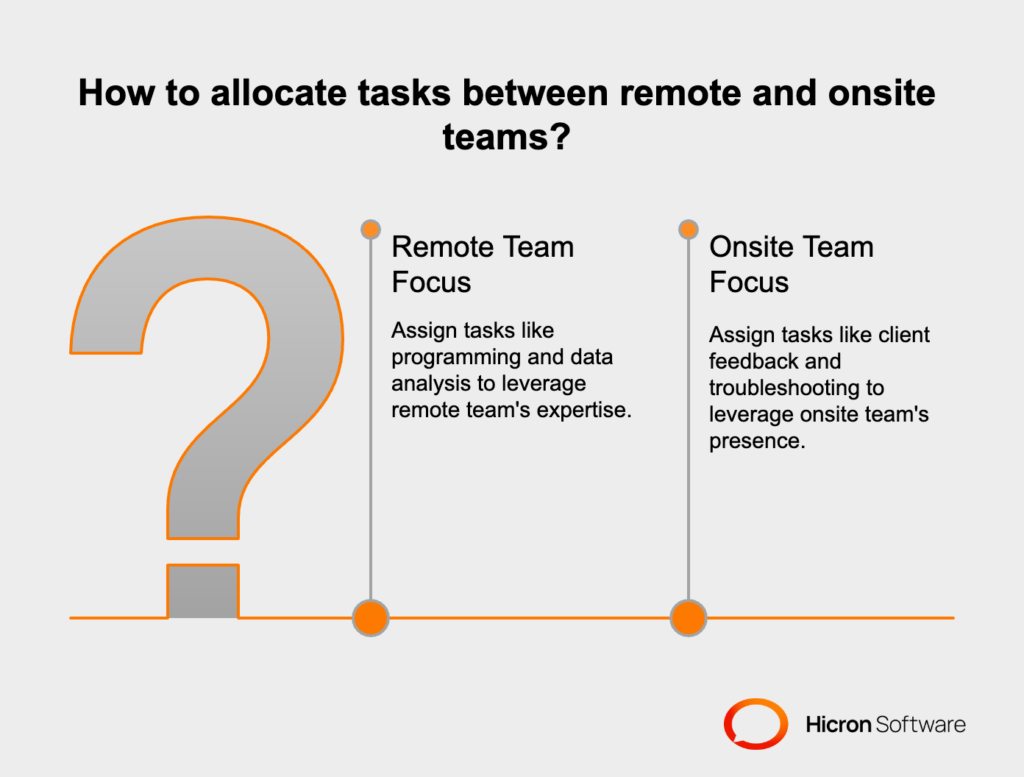
Conditions and priorities in tech partnerships often shift dynamically. A flexible approach allows for leveraging remote teams’ adaptability during periods of scalability while deploying onsite teams for urgent or complex tasks. Hybrid models thrive when companies remain open to adjusting workloads, communication plans, and workflows in response to changing demands.
Consider a tech startup developing a comprehensive SaaS platform. During the initial development stages, the company relied on remote teams located in Europe for design and coding, taking advantage of 24/7 productivity. For the platform’s beta testing and client onboarding phases, an onsite team in the U.S. worked directly with stakeholders to troubleshoot and rapidly implement feedback. This balanced approach combined efficiency, cost-effectiveness, and precision, leading to a seamless product launch.
By integrating the scalability of remote teams with the immediacy and cohesion of onsite resources, organizations can craft a hybrid model that adapts to the unique demands of tech partnerships. This balanced strategy not only improves project outcomes but also ensures resilience and innovation in the face of new challenges.
Curious about how to optimize your team structure for maximum impact? Start by identifying gaps in your current setup and explore strategies to blend remote and onsite teams seamlessly.
Managing hybrid teams effectively is essential for optimizing the potential of both remote and onsite teams in tech partnerships. A well-managed hybrid team combines the strengths of remote scalability and onsite collaboration, creating a dynamic, results-driven workflow. Here are key strategies to help you align a hybrid model for success.
Clear expectations are the foundation of any successful hybrid team. Define roles, responsibilities, and performance metrics for all members, whether they work remotely or onsite. This ensures everyone understands how they contribute to shared goals and eliminates confusion about priorities.
Actionable Tip:
Develop a comprehensive onboarding guide tailored to hybrid team dynamics. Include details about workflows, communication norms, and escalation protocols so that team members, regardless of location, have a clear roadmap for success.
Technology is the glue that holds hybrid teams together. Collaborative platforms like Slack, Trello, or Microsoft Teams allow for seamless communication and workflow management across remote and onsite locations. Video conferencing tools help maintain regular face-to-face interactions, fostering a sense of team cohesion despite physical distances.
Actionable Tip:
Implement a shared project management dashboard accessible to everyone involved. This provides real-time progress updates, reduces redundancies, and keeps remote and onsite members equally informed.
Cultural alignment is crucial for avoiding friction between remote and onsite teams. A shared understanding of company values, vision, and working norms ensures cohesive collaboration and a unified approach to problem-solving.
Actionable Tip:
Host regular cross-team meetings where both remote and onsite members can discuss not just project goals but also share personal updates or celebrate milestones. These moments help build a shared culture and improve team morale.
Trust is the linchpin of hybrid team productivity. Leaders must ensure transparency and fairness in decision-making, empowering both remote and onsite teams to contribute equally. Regular feedback loops also help build confidence and accountability.
Actionable Tip:
Adopt a “trust-first” leadership style. Start team meetings by acknowledging wins from both remote and onsite contributors, and encourage open conversations about challenges. This reinforces inclusivity and creates psychological safety across the team.

A mid-sized tech company implemented hybrid teams during the development of a cloud-based security app designed for enterprise clients. The remote team handled coding and testing tasks from multiple global locations, offering faster turnaround times and cost efficiency. Meanwhile, the onsite team concentrated on client engagement, troubleshooting, and incorporating real-time feedback. Weekly video check-ins and a shared task management tool kept both teams closely aligned, resulting in faster project completion and enhanced client satisfaction.
By setting clear expectations, leveraging the right tools, fostering cultural alignment, and actively building trust, organizations can unlock the full potential of their hybrid teams in tech partnerships. This balanced approach not only drives smoother collaboration but also ensures maximum impact and innovation in every project.
Real-world experiences offer invaluable insights into managing tech partnerships involving remote teams, onsite teams, or hybrid models. By understanding the lessons drawn from successful projects, organizations can refine their strategies to ensure greater collaboration and impactful outcomes. Here are key takeaways from navigating the complexities of these setups.
One of the most critical lessons is the importance of cultural alignment and shared values in tech partnerships. Whether working with remote teams spread across time zones or onsite teams operating from a central location, aligning on values is pivotal. When teams share a common understanding of organizational goals, they make decisions more cohesively, fostering a seamless workflow.
Fostering cultural alignment ensures that every team member, regardless of their physical location, feels connected to the organization’s mission. This shared alignment not only motivates but also minimizes conflicts, creating an environment conducive to collaboration.
Example Insight:
A tech company collaborating with international remote teams emphasized regular cross-team workshops to discuss the organization’s vision and values. This alignment led to improved decisions and stronger team bonds, despite operating remotely.
Tech partnerships often face rapidly shifting priorities, dependencies, and external factors. Teams that adopt a flexible approach to managing these obstacles tend to outperform those that remain rigid. Flexibility allows remote and onsite teams to adjust workflows, allocate resources as needed, and adapt communication styles to suit evolving conditions.
For instance, in projects involving hybrid teams, companies have adapted by redistributing roles based on real-time challenges. Remote teams may temporarily take on high-volume tasks, while onsite teams prioritize direct client interactions or critical troubleshooting.
Key Lesson:
Flexibility is not just reactive but proactive. Establish processes that accommodate change without losing momentum, enabling the partnership to thrive under varying circumstances.
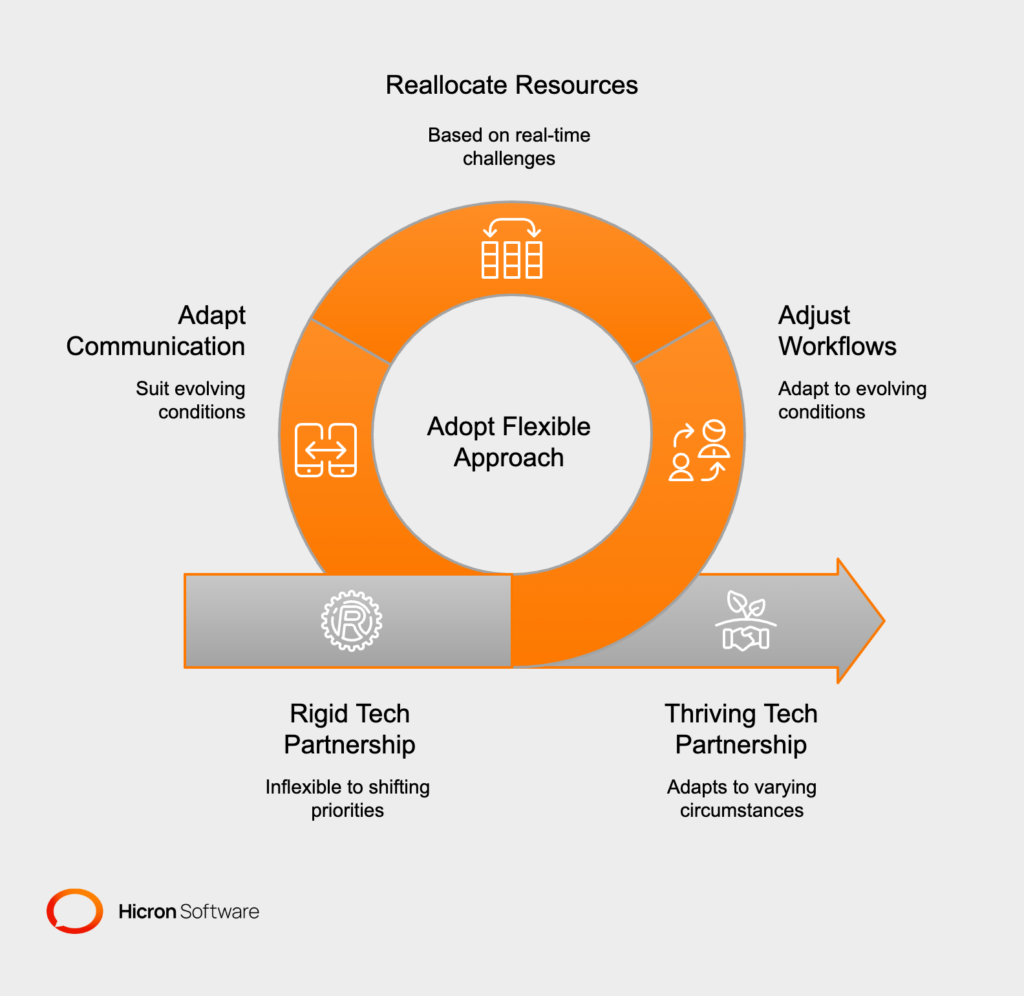
A successful tech partnership strikes a balance between technical expertise and interpersonal rapport. While technical prowess is non-negotiable, the ability to communicate and build trust across remote, onsite, and hybrid teams is equally crucial. Interpersonal skills help bridge gaps, resolve conflicts quickly, and ensure all team members feel valued.
Creating structured opportunities for team bonding can enhance interpersonal connections, leading to stronger collaboration. Virtual team-building sessions, in-person workshops, or even casual check-ins can help remote and onsite teams form meaningful connections.
Real-World Example:
During a global project, a tech company prioritized weekly virtual coffee hours alongside regular progress meetings. These informal sessions helped remote developers and onsite project managers develop mutual respect and understanding, leading to stronger overall collaboration.
At the core of every successful tech partnership involving remote and onsite teams lies an unwavering focus on trust, clear communication, and shared goals. Without these foundational pillars, even the most technically capable teams can falter.
Trust, clear communication, and shared goals were what ultimately led to our success is what you want to hear. These lessons, rooted in real-world experiences, demonstrate that building outstanding tech partnerships isn’t just about having the right teams in place but about creating the right environment for them to thrive.
Real-world applications of hybrid work models demonstrate how businesses can successfully combine remote teams and onsite teams to maximize efficiency and foster strong tech partnerships. Below is an in-depth look at how one company implemented a hybrid approach to achieve remarkable results.
A mid-sized software development firm was tasked with creating a custom AI-powered analytics tool for a global retail client. The company opted for a hybrid work model to balance cost, efficiency, and relationship-building.
To ensure smooth collaboration, the company utilized advanced project management tools and scheduled hours for real-time communication. This balance between cost-efficient offshore talent and local stakeholder management proved to be a game-changer.
The hybrid approach delivered exceptional results across multiple fronts:
By thoughtfully leveraging the strengths of both remote and onsite teams, businesses can meet their goals while cultivating strong, lasting tech partnerships.
Choosing the right team setup is crucial for achieving success in tech partnerships. By understanding the unique strengths of remote and onsite teams, and strategically blending them into hybrid models, businesses can unlock scalability, efficiency, and stronger relationships. Clear communication, trust, and cultural alignment are essential to ensuring smooth collaboration and long-term impact.
Our extensive experience working with teams from Europe and the US has equipped us to deliver exceptional results for our clients. By expertly managing remote, onsite, and hybrid teams, we’ve crafted tailored solutions that balance efficiency, scalability, and strong relationships. If you’re ready to take your tech partnerships to the next level, we’d love to collaborate with you. Reach out today to see how we can drive success together!
Services Related to Hybrid Work Models:
Case Studies for Real-World Examples:
Knowledge Sharing:
